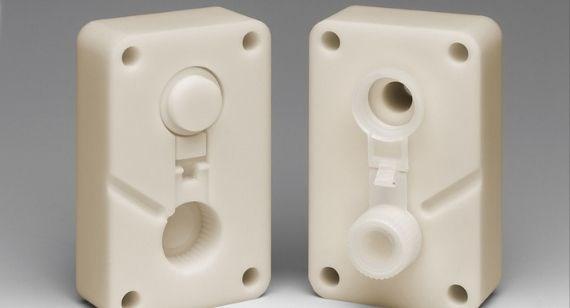- FMA
- The Fabricator
- FABTECH
- Canadian Metalworking
Our Publications
Categories
- Additive Manufacturing
- Aluminum Welding
- Arc Welding
- Assembly and Joining
- Automation and Robotics
- Bending and Forming
- Consumables
- Cutting and Weld Prep
- Electric Vehicles
- En Español
- Finishing
- Hydroforming
- Laser Cutting
- Laser Welding
- Machining
- Manufacturing Software
- Materials Handling
- Metals/Materials
- Oxyfuel Cutting
- Plasma Cutting
- Power Tools
- Punching and Other Holemaking
- Roll Forming
- Safety
- Sawing
- Shearing
- Shop Management
- Testing and Measuring
- Tube and Pipe Fabrication
- Tube and Pipe Production
- Waterjet Cutting
Industry Directory
Webcasts
Podcasts
FAB 40
Advertise
Subscribe
Account Login
Search
Is it better to 3D-print a plastic mold or CNC-machine it from aluminum?
- August 12, 2021
- News Release
- Additive Manufacturing
Digital contract manufacturer Protolabs recently posted a blog about whether it’s better to 3D-print molds from thermoplastic or machine them from aluminum. The Maple Plain, Minn., provider of injection molding, CNC machining, 3D printing, and sheet metal fabrication services concluded, “In most cases, use 3D printing for parts—prototype or end use—but not for molds.”
The company explained that molds made with thermoplastics-based 3D printing are “kind of like the plastic storage sheds some of us put in our backyards. They’re a little cheaper than metal sheds. They go up quickly and are fine under light loads. Pile too much snow on them, however, and they’ll collapse like a house of cards.”
Printed molds have their place, the blog continues, noting that some shops have had good success with them. “Proponents argue that 3D printing produces molds up to 90 percent faster and 70 percent cheaper than using traditional moldmaking processes. And while this may be true in some circumstances, it’s important to understand the pros and cons of printed plastic molds compared to those machined from metal.”
The primary advantage of a 3D-printed mold is its relatively low cost. Protolabs points out, though, that “with 3D-printed molds, you’ll need to print, machine-assemble, and test a new mold every 50 to 100 shots. Aluminum tooling has no such constraints, and often see[s] service well past 10,000 shots.”
Click here to read the entire blog.
Additional articles about 3D-printing molds:
- Podcasting
- Podcast:
- The Fabricator Podcast
- Published:
- 04/16/2024
- Running Time:
- 63:29
In this episode of The Fabricator Podcast, Caleb Chamberlain, co-founder and CEO of OSH Cut, discusses his company’s...
- Trending Articles
- Industry Events
16th Annual Safety Conference
- April 30 - May 1, 2024
- Elgin,
Pipe and Tube Conference
- May 21 - 22, 2024
- Omaha, NE
World-Class Roll Forming Workshop
- June 5 - 6, 2024
- Louisville, KY
Advanced Laser Application Workshop
- June 25 - 27, 2024
- Novi, MI

























